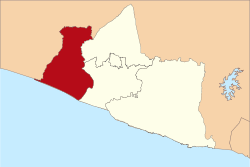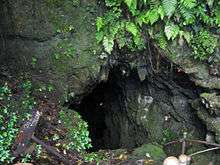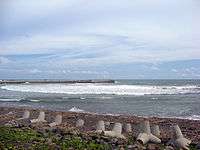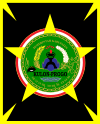Kulon Progo Regency
| Kulon Progo Regency Kabupaten Kulon Progo | ||
|---|---|---|
| Regency | ||
|
Glagah Beach, one of the black sand beaches in Kulon Progo regency. | ||
| ||
| Motto: Binangun | ||
 Kulon Progo Regency in Special Region of Yogyakarta | ||
| Coordinates: ID 7°38′42″S 110°1′37″E / 7.64500°S 110.02694°ECoordinates: ID 7°38′42″S 110°1′37″E / 7.64500°S 110.02694°E | ||
| Country | Indonesia | |
| Special Administrative Region | Yogyakarta | |
| Capital | Wates | |
| Government | ||
| • Regent | dr.H.Hasto Wardoyo,Sp.OG(K) | |
| Area | ||
| • Total | 586.27 km2 (226.36 sq mi) | |
| Population (2014) | ||
| • Total | 404,155 | |
| • Density | 690/km2 (1,800/sq mi) | |
| Time zone | WIB (UTC+7) | |
| Post Code | 55000 | |
| Area code(s) | 0274 | |
| Website | www.kulonprogokab.go.id | |
Kulon Progo Regency [ˈkulɔn pəˈroɡo] is one of the four regencies within the Yogyakarta Special Region, Indonesia. The name stems from the fact that the regency is located to the west (in Javanese "kulon") of the Progo River. The capital is Wates. The greatest part of the population of the regency work as farmers. Kulon Progo is surrounded by the Menoreh Hills. The area of the regency is 586.27 km², and the population was 388,755 at the 2010 Census; the latest estimate (for January 2014) is 404,155.
History
In 1674, Sultan Mataram, Yogyakarta attacked by Trunojoyo which received assistance from Macassar result in damage to the palace and terdesaknya Amangkurat I fled for help to the Netherlands, to death in Tegal in flight.
To anticipate attacks from followers Trunojoyo, in 1677 the palace of Mataram led by Amangkurat II as the crown prince of Amangkurat II asked the regent Ponorogo to get custody of the palace by bala Warok famous versed in war and asked for help from the Dutch colonial to mengkap Trunojoyo. After Mataram palace guarded by Warok of ponorogo, Tronojoyo difficult to penetrate the palace and was arrested and sentenced in death in 1679.
The Warok who managed to keep the palace got the prize a place to stay in the West of Guangxi palace to facilitate the preservation of the palace when there was an attack against the palace. The palace was named Kulon Ponorogo known until now the Kulon Progo which means Keraton Mataram western Ponorogo.
The area that currently includes the district of Kulon Progo until the end of Dutch colonial rule is the territory of two districts, namely Kulon Progo which is a region of the Sultanate Ngayogyakarta and District Adikarto which is a region of the Duchy Pakualaman. Both districts are merged into Kulon Progo administration on October 15, 1951.
Administrative districts
Kulon Progo Regency is divided into 12 districts, listed below with their populations at the 2010 Census:[1]
- Temon (24,471)
- Wates (43,995)
- Panjatan (33,397)
- Galur (29,120)
- Lendah (36,447)
- Sentolo (44,525)
- Pengasih (45,175)
- Kokap (31,124)
- Girimulyo (21,893)
- Nanggulan (27,239)
- Kalibawang (26,802)
- Samigaluh (24,681)
Forestry
Some local development efforts, carried on with the support of local cooperatives, work towards reafforestation activities. Trees being planted in the regency for both commercial and social reasons include Jati (Teak or Tecnona grandis), Mahogany (Swietenia mahagoni), Albasia (Albizia), and sono keliling (Blackwood or Rosewoon, Dalbergia latifolia).[2]
New International Airport
The central Indonesian government has indicated that a new airport for the Yogyakarta Special Region will be located in the Kulon Progo Regency. The plan is to build an airport with a 3,250 metre runway with 45 meters width and dual linear terminals to serve as an international gateway. The initial plan is to provide facilities to serve up to 10 million passengers per year for 28 aircraft together. Later expansions might accommodate up to 20 million passengers per year in phase-3. Around 637 hectares of land is being set aside for the project. Of this, 40% is classified as "Paku Alam (Sultan)" land while the rest belongs to local communities. The location is in Temon District between Congot Beach and Glagah Beach (which covers Palihan village, Sindutan village, Jangkaran village and Glagah village). In August 2013, 75 percent of land has been occupied.[3][4]
An airport train has been planned to serve Yogyakarta and the airport. The rail use existing rail plus 4 kilometers new rail from Kedundang Station to Temon Airport. Due to new rail is only short, so the train hopefully will be ready when the airport is ready to operate.[5]
Sermo Dam
Sermo Dam in Kulon Progo Regency is the best dam in water quality among dams in Indonesia, with minimal sedimentation. The area of the reservoir formed by the dam is 21.3 square kilometres with 21.9 million cubic metres of reservoir and functioning for 7,152 hectares irrigation, 150 litres/second of water treatment and 50 litres/second for cleaning of Wates City drainage.[6]
References
- ↑ Biro Pusat Statistik, Jakarta, 2011
- ↑ Nani Afrida, 'Kulon Progo: Invests in green future', The Jakarta Post, 10 April 2013.
- ↑ "Yogyakarta bakal Miliki Bandara Baru Seluas 637 Hektare". August 10, 2012.
- ↑ "Bandara Kulon Progo Siap Tiang Pancang". August 23, 2013.
- ↑ Suprapto (October 14, 2015). "Kereta Api Layani Penumpang Bandara Kulo Progo Yogyakarta".
- ↑ "Memiliki Kualitas Air Bagus, Waduk Sermo Terbaik di Indonesia". August 26, 2013.


